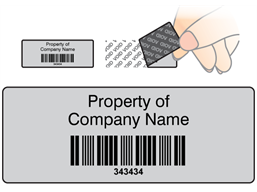
What is asset tagging?
Asset tags are essential for businesses that have physical assets that need to be inventoried, tracked and regularly monitored for calibration needs. Before asset tagging, information of your company’s assets was entered manually into a spread sheet, relying on someone to have entered the correct information. Asset tagging eliminates the need for manual data entry and therefore reduces human errors, so you r documentation is more accurate.
Why Do I need to Tag my assets?
Inventory control: by scanning every item in your inventory when it is being entered or removed will automatically keep your records up to date and accurate. Meaning that you can plan re-orders, and schedule delivery as and when is needed.
Theft Prevention: asset tags themselves work as a theft deterrent. Label Source also stock a range of tamper evident asset tags which alert the inventory manager of unauthorised removal / transfer or attempts of theft.
Maintenance Management: If you are relying on physical assets to run your business, it is important to keep an up to date document of when their last service, calibration, or maintenance check was to prevent any system downtime.
Asset Monitoring: Know exactly where your assets are.
What can I label?
Asset tagging simply allows you to keep track of where your physical assets are and what condition they are in, inventory and supplies. So what exactly do you need to label?
You may need to tag all of your companies Fixed assets, these are assets that you have purchased for long term use, and are not likely to be converted into cash quickly. For example, computers, office equipment and machinery. tagging these items will enable tracking and scheduling maintenance of these assets to ensure that they are running smoothly at all times, preventing any service
If you are working in an environment where goods are being delivered and distributed daily (warehouses, hospitals, stock rooms), inventory control is essential asset tagging can help by eliminating excessive Stock being ordered and streamlining the ordering and delivery process.
If you are working in either the telecoms industry or the IT industry, asset tagging your wires will allow you to respond to issues, such as outages and part ordering and replacement to improve company efficiency.
External assets If you have external assets, for example, waste collection bins. Tagging these will allow you to keep an up to date database on repairs, replacements and maintenance of these assets.
Click here for more information on our asset tags and to browse our Asset tag Department.
If you cannot the exact tag that you are looking for create your own with our simple custom asset tag builder. If you have any questions regarding asset tags or our custom asset tag builder contact us by calling 0800 3761 693 or emailing info@laelsource.co.uk